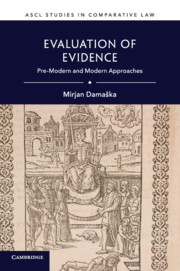Book contents
- Evaluation of Evidence
- ASCL Studies in Comparative Law
- Evaluation of Evidence
- Copyright page
- Dedication
- Epigraph
- Contents
- Acknowledgments
- Prologue
- 1 The Origin of Roman-Canon Legal Proof in Criminal Cases
- 2 Epistemic Foundations
- 3 Orientation in the Labyrinth
- 4 The Two-Eyewitnesses Rule
- 5 The Probative Impact of Confessions
- 6 The Negative Effect of Legal Proof
- 7 The Rejection of Persuasive Evidence
- 8 Evading the Roman-Canon Full Proof Standard
- 9 Recapitulation
- 10 Continental Successors to Roman-Canon Legal Proof
- 11 Roman-Canon Legal Proof and Common Law Evidence
- Epilogue
- Index
Epigraph
Published online by Cambridge University Press: 13 December 2018
- Evaluation of Evidence
- ASCL Studies in Comparative Law
- Evaluation of Evidence
- Copyright page
- Dedication
- Epigraph
- Contents
- Acknowledgments
- Prologue
- 1 The Origin of Roman-Canon Legal Proof in Criminal Cases
- 2 Epistemic Foundations
- 3 Orientation in the Labyrinth
- 4 The Two-Eyewitnesses Rule
- 5 The Probative Impact of Confessions
- 6 The Negative Effect of Legal Proof
- 7 The Rejection of Persuasive Evidence
- 8 Evading the Roman-Canon Full Proof Standard
- 9 Recapitulation
- 10 Continental Successors to Roman-Canon Legal Proof
- 11 Roman-Canon Legal Proof and Common Law Evidence
- Epilogue
- Index
- Type
- Chapter
- Information
- Evaluation of EvidencePre-Modern and Modern Approaches, pp. viPublisher: Cambridge University PressPrint publication year: 2018

